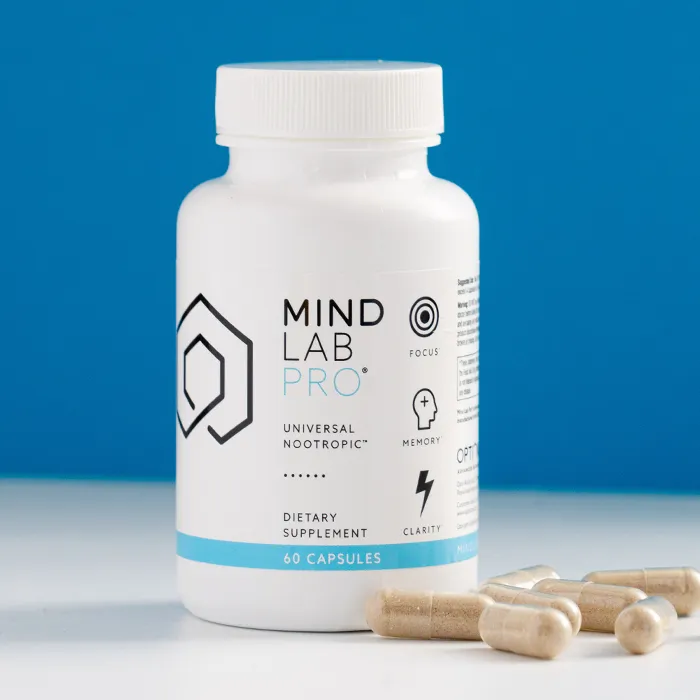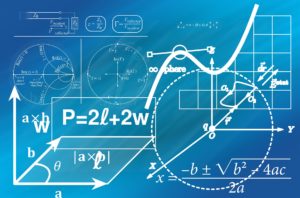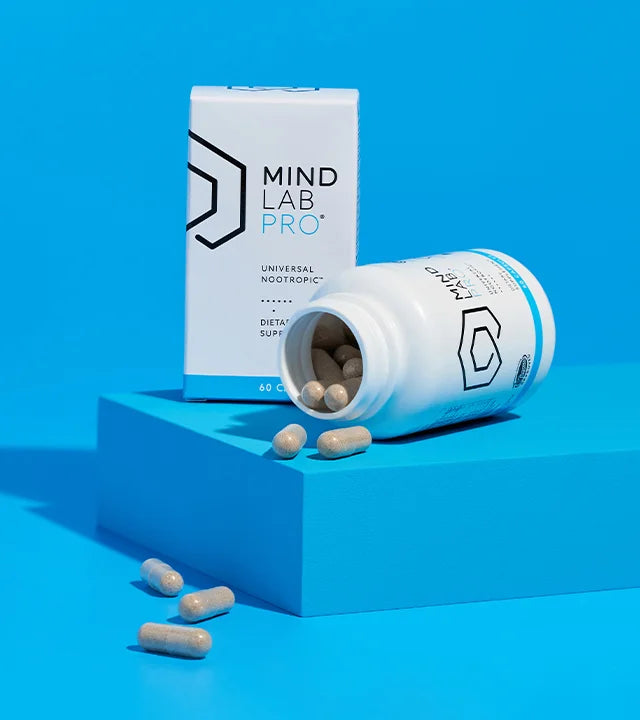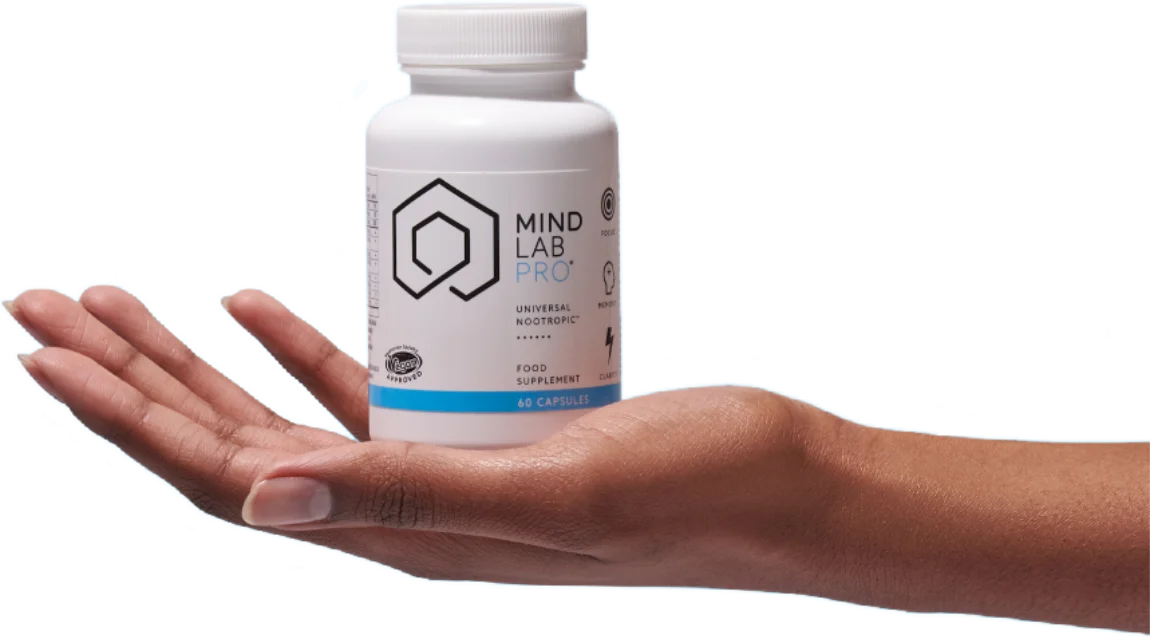The small amount of knowledge we possess about how the human brain processes mathematics barely hints at the myriad interfaces between the two. But recent breakthroughs have allowed neuroscientists to explore whether the brain of a math whiz operates at a higher cognitive level... and how brain-boosting nootropics for math might help.
Although abstract mathematical reasoning is often considered an exclusively human endeavor, many species – from poultry to primates – exhibit some ability to grasp numerical concepts. This suggests that basic numerical abilities pave the evolutionary foundation for higher math in humans.
Here we’ll discuss various ways the brain processes mathematical concepts and how nootropics for math could help boost related cognitive functions.
Key Takeaways
- What helps math most: attention control, working memory, processing speed, and test-anxiety regulation.
- Acute support (mins–hours): L-Theanine (calm focus), Rhodiola (anti-fatigue), NALT/L-Tyrosine (under stress), moderate caffeine if tolerated.
- Build-over-time (2–8 wks): Citicoline, Bacopa, maritime pine bark, PS—support memory, clarity, and accuracy.
- Protocol: practice consistently, stack conservatively, time doses earlier in the day, and don’t try anything new on exam day.
- Mind Lab Pro® combines multiple research-backed ingredients to support the cognitive skills math relies on—without stimulants.

Best nootropics for math in 1 stack: Mind Lab Pro®
Mind Lab Pro®: This all-in-one nootropic stack is designed to improve focus, memory, and mental clarity, making it a strong candidate for those seeking to boost their mathematical abilities. It's stimulant-free, safe and healthy for the brain, and backed by two research studies, including one suggesting it improved memory. Buy Mind Lab Pro Now
The Language of Mathematics

Mathematics has long been dubbed the language of science.(1) Dating back to the 16th century, Italian astronomer and physicist Galileo Galilei claimed mathematics is the language of the universe in his eminent work, Opere Il Saggiatore.
The term "language" encompasses many definitions, but whichever definition is used, all language contains the following components:
- A vocabulary of words or symbols.
- Meaning attached to the words or symbols.
- Grammar – a set of rules that outline how vocabulary is used
- Syntax which organizes symbols into linear structures
- A narrative or discourse consisting of syntactic propositions.
- A group of people who use and comprehend the symbols (present or past)
Since it meets all of these requirements, mathematics is a language by definition. And it’s a universal language. Mathematical symbols and their meanings are the same throughout the world.
Mathematicians, scientists, and computer programmers use math to communicate and create mathematical formulas and software programs that communicate ideas and theories, from rational to abstract concepts.
The Language Command Center
The left hemisphere encompasses parts of the parietal, temporal, and occipital lobes which comprise the language command center. Wernicke’s and Broca’s areas couched within these lobes enable language recognition and allow us to read and speak in specific language patterns – including mathematical languages.
Left Hemisphere vs. Right Hemisphere
In the past, scientists believed that left and right brain hemispheres command different learning-related functions.
According to popular theory, the logic-focused left hemisphere controls things like math and language, while the abstract-oriented right hemisphere directs less rigid abilities like visual imagery, music, and facial recognition.
While current research does support the core of this theory, new findings indicate that number tasks are mostly driven by the right brain while the left brain dominates calculation tasks.
Nootropics for math support neural communication between the two hemispheres, improving overall cognitive function for better math skills.
Related Post: Nootropics for Poker - Win More with Game-Changing Brain Boosters
The Brain Myth
Research conducted at Ghent University in 2012 indicates that while each brain hemisphere specializes in executing certain tasks and learning specific functions, both hemispheres are responsible for most cognitive functions, including math-related ones.
For example, the left brain is primarily responsible for language learning, but neural plasticity allows the right brain to assume responsibility in certain cases.(2)
How the Brain Processes Math
But the brain’s relationship with math goes way beyond language-processing. In fact, the brain mainly uses the same neural networks to process both high-level math concepts and the basic math skills a child is born with.
Children can grasp basic mathematical concepts like size and number before they learn the words that describe them, but very little is known about the neural mechanisms behind these abilities. So researchers at the INSERM–CEA Cognitive Neuroimaging Unit in France arranged a study to find out more.
- The team used fMRI to scan the brains of 15 professional mathematicians and 15 nonmathematicians of the same academic level. Participants listened to 72 high-level mathematical statements in algebra, geometry, analysis, and topology – and 18 high-level nonmathematical (mostly historical) statements. They were given four seconds to reflect on each statement and decide whether it was true, false, or meaningless.(3)
The results showed that listening to math-related statements activated a network incorporating bilateral intraparietal, dorsal prefrontal, and inferior parietal regions of the brain – but only in the mathematicians. Notably, this circuitry is not traditionally associated with language processing.
But predictably, known language-processing networks were activated in both mathematicians and nonmathematicians when presented with nonmathematical statements. Study co-author Marie Amalric summed up the study’s conclusion, saying
“Our results show that high-level mathematical reflection recycles brain regions associated with an evolutionarily ancient knowledge of number and space.”
Other research has found that performing rudimentary arithmetic calculations (and even just seeing numbers) activates the same nonlinguistic areas, suggesting a link between basic and advanced mathematical thinking.
This information could help explain why the brain taps into the same neural networks to process both high-level math and a child’s basic counting exercise.
Inferior Parietal Lobule
The inferior parietal lobule, also called Geschwind’s territory, is located midway down the primary language pathway, connecting Broca’s area and Wernicke’s area. This region includes the angular gyrus and the supramarginal gyrus located in both right and left parietal lobes.(4)
Specifically, the right inferior parietal lobule controls number tasks, whereas the left inferior parietal lobule is activated during calculation tasks.
The inferior parietal lobule is associated with both language and mathematical operations. This makes strong activity in this brain region particularly useful for coding, engineering, science, and other mathematically dense fields.
Less talked about, the insula and claustrum are also important for processing number tasks. The insula connects the temporal and frontal lobes deep within the lateral fissure, and the claustrum borders the insula.(5)
Dorsal Prefrontal
Partnering with the IPS, a cluster in the left brain comprised of the left precentral gyrus, inferior gyri, and middle frontal gyri also respond to calculation tasks. The middle frontal gyri, also called the dorsolateral prefrontal cortex, govern executive cognitive functions associated with attention and working memory.
Research studying mathematical cognition in general links activity in the middle frontal gyri with procedural complexity and working memory processes used during calculation tasks.
Studies that specifically examine numerical processes typically ask subjects to select the largest number in a set of numbers. When the numerical difference is small, the superior parietal lobe, medial and inferior frontal gyri, the insula, and subcortical regions activate – mostly in the right hemisphere.
But when number differences are large, the dorsolateral prefrontal cortex, inferior frontal gyrus, and intraparietal sulcus activate – mostly in the left hemisphere.
Intraparietal Sulcus
The intraparietal sulcus (IPS) is activated during tasks requiring attention and manipulation of information in working memory.
Both human and nonhuman primate studies link the IPS with a range of cognitive functions, including attention and short-term and working memory but also spatial imagery and mathematical cognition.(6)
- A Duke University study examined adults and preschool children to analyze how the IPS responds to nonsymbolic numerical values. The study confirms that the brain circuitry governing nonsymbolic numerical processing develops very early in human development, even suggesting the IPS prompts numerical processing as early as infancy.(7)
The location and pattern of brain activity for nonsymbolic numerical processing and basic math in the preschoolers resembled that of adults. By four years old, children's brains already selectively respond to nonsymbolic numerical values, confirming the neural networks for number processing are established early in life.
Cognitive Function for Math
Working Memory
When information is considered valuable, working memory stores it in several brain locations, depending on the type of information.
Working memory (including recall) can retain about seven pieces of information at once for about 30 seconds. The brain can then manipulate that information appropriately in the present moment.
We use working memory to remember number sequences, solve hard math problems, and perform technology-related tasks like coding.
More on Mind Lab Pro® nootropics for memory
It has enabled me to concentrate more and remember more things than before using it.David Z.

Language
Mathematics is called the language of science. And both mathematics and language work within the same brain regions for certain types of mathematical tasks.
Since they share some of the same neural pathways, like Broca’s and Wernicke’s areas, having good language skills could help enhance some math-related skills like computer programming.
More on Mind Lab Pro® nootropics for language
Significant difference in alertness when I take these! What's also VERY noticeable is how I can better articulate, esp in a foreign language when I take Mind Lab Pro!Julia D.

Coding
There are a wide variety of coding languages to choose from, and some are more mathematical than others. So when you’re coding for tech-intensive topics like science and engineering, brain regions associated with both language and number processing really light up.
But writing code is number based, and though it draws on multiple cognitive functions from attention to working memory to motivation, it sparks activity in number-focused brain regions like the middle frontal gyrus and inferior parietal lobule.
More on Mind Lab Pro® nootropics for computer programming
I'm developing a project which provides constant surges of exciting opportunistic energy that Mind Pro has channeled into calm, creative organized patterns that have made me more productive!George J.

Learning
Learning is important for every level of math. Although math is a universal language, we are always discovering new concepts, propositions, and applications for it. Without learning, math skills would be pretty useless.
The insula is directly responsible for numerical processing tasks. Activity in the insula and subcortical structures like the basal ganglia have been implicated in studies involving learning and training.(8)
Plus, strong activity in these areas may also influence motivation for learning and performing math-related tasks.
More on Mind Lab Pro® nootropics for learning
I find MLP helps me to focus & learn. It is the ideal supplement for a more productive day.David M.

Best Nootropics for Math
Nootropics boost cognitive functions necessary for solving, interpreting, and creating mathematical equations and syntax. Some popular nootropics for math and reasoning include harsh stimulants that can confer unwanted side effects. Here are some of the best all-natural nootropics for math.
N-Acetyl L-Tyrosine

High-level mathematical operations can be highly stressful. Even basic math like algebra or geometry can be stressful for some people. And good working memory is critical for mathematical success at any level.
When confronted with stressful conditions, the brain consumes catecholamines at a higher rate, depleting stores of cognition-boosting neurotransmitters.
The catecholamines dopamine, epinephrine, and norepinephrine, help with focus, concentration, and memory. Once those chemical levels drop, cognition gets fuzzy.
- NALT increases levels of catecholamines like dopamine and norepinephrine in the brain. And it helps boost mental energy while multitasking by strengthening catecholamine supply and release.(9)
L-Tyrosine helps boost math skills by protecting working memory during periods of high stress. As a precursor to catecholamine conversion, l-Tyrosine helps replenish the brain’s capacity to maintain top cognitive function under pressure.
More on Mind Lab Pro® N-Acetyl L-Tyrosine
Bacopa Monnieri

Bacopa monnieri is an ancient Ayurvedic adaptogen valued for its multipurpose brain benefits. Backed by piles of research, Bacopa is popular among brain hackers and nootropic enthusiasts for its cholinergic memory enhancement mechanisms.
- Studies show that chronic Bacopa supplementation can improve “higher order cognitive processes that are critically dependent on the input of information from our environment such as learning and memory.”(10)
While some nootropic buffs supplement Bacopa for its stress adaptive benefits, math aficionados use it as a learning accelerator and memory-enhancer.
More on Mind Lab Pro® Bacopa Monnieri
Lion’s Mane Mushroom

Clinical evidence shows Lion’s Mane mushroom can support the synthesis of brain-boosting Nerve Growth Factor (NGF).(11)
NGF helps protect and rebuild neurons and facilitates the new growth of brain cells and neural pathways by promoting neuroplasticity.
The brain’s mechanisms for managing mathematics involve both brain hemispheres. Lion’s Mane could help improve math skills by supporting new neural connections between the two.
More on Mind Lab Pro® Lion’s Mane
Best Nootropic Stack for Math in 2025
Mind Lab Pro®

Mind Lab Pro® (MLP) combines 11 research-backed nootropics that each deliver multiple brain health and cognitive benefits into one potent nootropic stack.
The formula is designed for a whole-brain boost that flexes to meet dynamic cognitive needs -- including the focus, multitasking, processing, and clarity required for sharp mathematics-related thinking.
MLP ingredients include many of the best nootropics for math:
- Citicoline, 250 mg
- Phosphatidylserine (PS), 100 mg
- Bacopa monnieri, 150 mg (full-spectrum extract, 24% bacosides with 9 bioactives)
- Organic Lion's Mane Mushroom, 500 mg (fruit and mycelium)
- Maritime Pine Bark Extract, 75 mg: (Standardized to 95% proanthocyanidins)
- N-Acetyl L-Tyrosine, 175 mg
- L-Theanine, 100 mg
- Rhodiola rosea, 50 mg (Standardized to 3% rosavins and 1% salidrosides)
- NutriGenesis® B-Vitamins: Vitamin B6 (2.5 mg), Vitamin B9 (100 mcg), Vitamin B12 (7.5 mcg)
Math performance improves when attention is steady, anxiety is low, and working memory is free to hold intermediate steps—not just the final answer.
MLP can not only support math ability, it provides many complementary cognitive benefits to help with academics, professional life, test performance and more. It supports:
- Focus, attention and concentration
- Mental energy without caffeine or crashing
- Sharp cognition under stress and multitasking
- Memory: short-term, long-range, learning, recall
- Quick processing speed Healthy mood balance
- Overall brain function
- Learning capacity
Mind Lab Pro® is Backed by Research.
Finally, MLP is the best nootropic stack for math because its formula has been validated by two well-designed human clinical trials. Let's take a look at what the research suggests:
- Researchers reported that subjects taking Mind Lab Pro for 30 days experienced significant improvements in performing information processing (reaction time) tasks related to focus, attention and quick thinking.(12)
- A second study linked Mind Lab Pro to significant improvements across all memory functions that were tested, including immediate recall, delayed recall, auditory, visual and visual working memory.(13)

Summary
Nootropics for math enhance right and left brain functions for 100% Brainpower™ and rock solid mathematical skills.
Mind Lab Pro® is the world’s first Universal Nootropic™ and the greatest of all nootropic stacks, supporting working memory and learning while targeting brain regions that directly influence symbolic and nonsymbolic mathematical propositions.
- Mind Lab Pro®'s integral approach enhances neural communication between both brain hemispheres, helping you achieve optimal mental performance and the combined cognitive power you need to excel in math-heavy fields and STEM careers.
Brain supplements won't turn you into a math whiz overnight, and there's no substitute for good nutrition and a balanced lifestyle to ensure a healthy brain. Mind Lab Pro® nootropics for math could help boost your brainpower and give you the extra edge you need to achieve 100% Brainpower™.
Optimizing brain function with nootropics can offer a significant advantage for individuals looking to improve their mathematical skills.
By enhancing focus, memory, and stress management, nootropics like Mind Lab Pro® can support both basic arithmetic and complex mathematical reasoning.
While they can't replace practice and learning, these cognitive enhancers can provide an edge for those looking to excel in math-heavy fields, from engineering to computer programming, by maximizing cognitive performance and boosting mental clarity.
References
- Ford A, Peat FD. The Role of Language in Science. Foundations of Physics. 1988, Vol 18, Issue 12, pp 1233–1242.
- Boehm K. Left Brain, Right Brain: An Outdated Argument. Yale Scientific. 15 Apr 2012.
- Amalric M, Dehaene S. Origins of the brain networks for advanced mathematics in expert mathematicians. PNAS 11 Apr 2016. doi: 10.1073/pnas.1603205113
- Ford A, et al. STRUCTURAL CONNECTIVITY OF BROCA’S AREA AND MEDIAL FRONTAL CORTEX. Neuroimage. 2010 Oct 1; 52(4): 1230–1237. doi: 10.1016/j.neuroimage.2010.05.018
- Arsalidou M, et al. Brain areas associated with numbers and calculations in children: Meta-analyses of fMRI studies. Developmental Cognitive Neuroscience. Volume 30, April 2018, Pages 239-250. doi: 10.1016/j.dcn.2017.08.002
- Rosenberg-Lee M, Chang TT, Young CB, Wu S, Menon V. Functional dissociations between four basic arithmetic operations in the human posterior parietal cortex: a cytoarchitectonic mapping study. Neuropsychologia. 2011. 49:2592–2608. doi: 10.1016/j.neuropsychologia.2011.04.035
- Gross L. A Neural Seat for Math? PLoS Biol. 2006 May; 4(5): e149. doi: 10.1371/journal.pbio.0040149
- Chein JM, Schneider W. Neuroimaging studies of practice-related change: fMRI and meta-analytic evidence of a domain-general control network for learning. Brain Res Cogn Brain Res. 2005 Dec;25(3):607-23. doi: 10.1016/j.cogbrainres.2005.08.013
- Neri, DF, Wiegmann D, Stanny RR, Shappell, SA, McCardie A, McKay, DL. The effects of tyrosine on cognitive performance during extended wakefulness. Aviat Space Environ Med. 1995 Apr;66(4):313-9.
- Stough C et al. The chronic effects of an extract of Bacopa monniera (Brahmi) on cognitive function in healthy human subjects. Psychopharmacology (Berl). 2001 Aug; 156(4): 481-4.
- Mori K, et al. Nerve growth factor-inducing activity of Hericium erinaceus in 1321N1 human astrocytoma cells. Biol Pharm Bull. 2008 Sep;31(9):1727-32
- Utley A, Gonzalez Y, Imboden CA. The Efficacy of A Nootropic Supplement on Information Processing in Adults: A Double Blind, Placebo Controlled Study. Biomed J Sci & Tech Res 49(1)-2023. BJSTR. MS.ID.007746
- Abbott-Imboden C., Gonzalez Y., Utley A. (2023). Efficacy of the nootropic supplement Mind Lab Pro on memory in adults: Double blind, placebo-controlled study. Human Psychopharmacology: Clinical and Experimental, e2872. https://doi.org/10.1002/hup.2872

